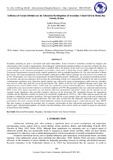| dc.contributor.author | Sifuna, Andrew Barasa | |
| dc.contributor.author | Ouda, James Bill | |
| dc.contributor.author | Otieno, Kenneth | |
| dc.date.accessioned | 2023-10-05T08:01:39Z | |
| dc.date.available | 2023-10-05T08:01:39Z | |
| dc.date.issued | 2023-09-30 | |
| dc.identifier.uri | https://doi.org/10.51867/ajernet.4.2.42 | |
| dc.identifier.uri | https://ajernet.net/ojs/index.php/ajernet/article/view/127/104 | |
| dc.identifier.uri | http://ir-library.mmust.ac.ke:8080/xmlui/handle/123456789/2324 | |
| dc.description.abstract | Secondary schooling for girls is associated with much vulnerability. Sexual research is sometimes curtailed by religious and cultural taboos that consider it inappropriate. Given that girls’ education participation continues to experience setbacks that have a sexual bearing, research breaching these taboos is justified. Hence, the purpose of this study was to investigate the influence of sexual attitudes on the education participation of secondary school girls in Homa Bay County (HBC). The study adopted a Concurrent Transformative research design- majorly quantitative with an embedded qualitative bit. The study took place in Homa Bay County. The targeted population was all secondary school girls in HBC. Solvin’s formula was used to arrive at a sample size of 393. Respondents were chosen by proportionate stratified sampling method. Additionally, one guidance/counselling teacher, one principal and one area education director from the participating schools were purposefully included in the study to provide complementary qualitative data. Data from female students was collected by means of questionnaires while interview schedules were used to collect data from the rest of the participants. The validity of the test was established through expert input and adaption of tests used in similar studies. A pilot study was conducted to ensure instrument efficiency. Instrument reliability was confirmed by a test-retest test that returned a correlation coefficient of 0.786. The quantitative data was coded and analyzed using SPSS version 24.0. Linear regression was run between education participation and gender norms and the outcome was an equation model. Qualitative data provided evaluative references in the discussion. The relationship between the independent variables and the dependent variable was found to be statistically significant (t= 29.576, p <.001). Data evidence against the null hypothesis validated the alternative hypothesis. The study found that the sexual attitudes of the majority of the girls in Homa Bay County were inclined towards sexual gratification. The study data revealed that this behaviour undermined girls’ education participation. The study recommends that school authorities promote the formation of girls’ sexual sobriety peer teams (SSPT) that meet regularly to unpack the potential risks of romantic relationships on their educational participation. Interventions to improve girls’ education participation will benefit from these findings. More similar studies are needed to gauge the plausibility of generalizing these findings. | en_US |
| dc.language.iso | en | en_US |
| dc.publisher | AFRICAN JOURNAL OF EMPIRICAL RESEARCH | en_US |
| dc.subject | Influence,Sexual, Attitudes,Education, Participation, Secondary School, Girls, County | en_US |
| dc.title | Influence of Sexual Attitudes on the Education Participation of Secondary School Girls in Homa Bay County, Kenya | en_US |
| dc.type | Article | en_US |

